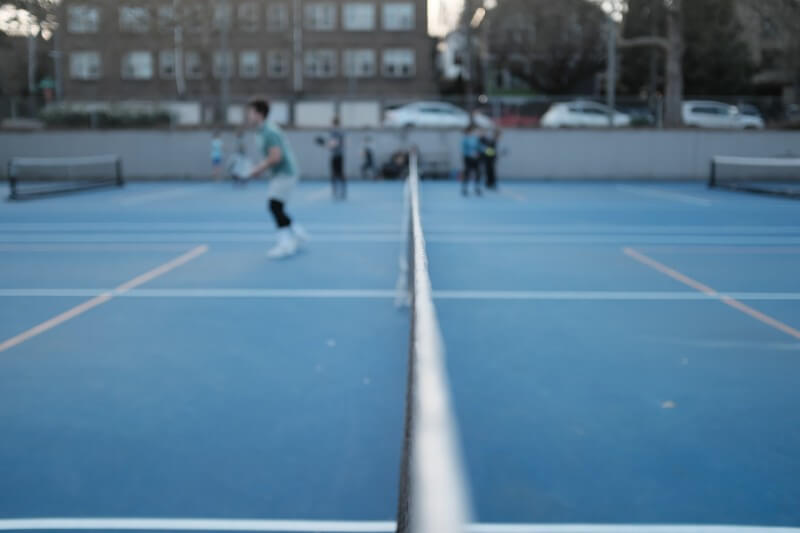What are the key requirements for designing the right pickleball court?
The game of pickleball may have been around since the 1960s, but the craze is not dying down anytime soon. Today, you can set-up a pickleball court with core consideration for some of the important requirements when designing it.
This article discusses some of the major considerations and requirements needed to building the perfect pickleball playing place.
Steps to Building a Pickleball Court
While some pickleball courts can be DIYed, it makes sense to leave everything in the hands of the professionals. One fact that cannot be ruled out is that the choice of materials, the location and the needs of the owner must be factored-in.
For these reasons, we have made a list of some of the things you need to know, as they help make the pickleball court practicable.
1. Find the Right Space
Having enough open ground to play is the key to enjoying the game of pickleball. As an intending, the space you opt for must comply with the following requirements:
- It should be easily-accessible.
- Enough spaces should be available to build the court and leave room for any extras.
- Are you building from scratch or repurposing an existing court, such as a volleyball or badminton court?
Here are tips to getting the right location for the pickleball court:
a. Consider the Dimensions
The ideal dimension should be 20-feet wide and 44-feet long – just enough to accommodate both single and double matches.
b. Consider the Playing Area
This is the major emphasis, because this is where the players will use. The ideal measurement is 30-feet wide and 60-feet long; though a measurement of 34 feet by 64 feet is feasible too.
c. Factor-in the Net Height
The height of net should be anywhere between 36 inches (for the sidelines) and 34 inches (in the middle).
2. Let’s Look at the Court Layout
The layout of the court majorly deals with the lines. Here, you must take note of the likes of service areas and baselines.
a. Service Area
This layout is where the players will “serve” or put the pickleball in play. It is typically located on either side of the centerline.
b. Baselines
These lines are strategically-located at the end of the court and made parallel to the net.
c. Non-Volley Zone
The Non-Volley Zone (NVZ) is marked by a line parallel and is about 7 feet away from the two sidelines and the net.
d. Centerline
The Centerline moves down from the baselines towards the Non-Volley Zone (NVZ). It is used to demarcate the pickleball court.
e. Sidelines
These lines run throughout the court.
Also Read:
- What is Rendering in Interior Design?
- Architectural Symbolism: Decoding Hidden Meanings in Buildings
3. Decide on the Base Materials
These are the surface types or surface materials, used to improve the aesthetics of the pickleball’s surface.
The selection of these base materials is subject to the following:
a. Space
The amount of space you have shortlisted for constructing the pickleball court will help determine the type of material to use for the surface.
b. Mode of Construction
The choice of base materials will also differ by the method of constructing the pickleball court. The common construction methods are:
- Building from scratch
- Revamping or repurposing an existing court, such as turning a badminton court into a pickleball court.
Types of Pickleball Court Base Materials
Here is a list of some common base materials to use:
Asphalt
Go for this if you are setting up an outdoor pickleball court. It is recommended for these reasons:
- Faster construction
- Adaptable and;
- Affordability
On the flip side, asphalt requires extra maintenance, especially by putting down a layer of concrete and applying a surface finish at the top.
Concrete
This is another practicable base material for pickleball courts. Concrete is not only durable, but requires low maintenance, is more affordable, and offers higher crack resistance, as the cracks don’t spread as fast as asphalt does.
Plastic Tiles
These base materials offer a temporary surface solution and are more expensive than concrete and asphalt.
Polyurethane
Go for this type of pickleball base material if you are building an indoor court. In addition, polyurethane pickleball courts offer a slight cushion to prevent ankle and knee injury.
On the downside, this type of base material is slightly expensive because it needs to be applied over a concrete surface.
However, it makes up for this by providing better shock absorption and greatly extending the court’s lifespan.
4. Shop for the Net Systems
The two popular net systems are portable and permanent. As you know, the pickleball court needs a net to make the gameplay exciting.
A professional will help you pick the right one, as per your needs.
a. Portable Net Systems
These are the pickleball nets that can be moved. Hence, they don’t need to be installed on the ground, but temporal used anywhere – both indoors and outdoors.
b. Permanent Net Systems
These are the opposite of the portable net systems because they need to be installed on the ground.
Portable vs. Permanent Net Systems
The obvious difference between the two is that one can be moved around and the other needs to be installed.
However, these are some of the additional differences:
- Permanent net systems give that “professional feel,” as they are installed and left for the players to use anytime.
- Most permanent net systems are equipped with materials that can weather the elements with ease.
Downsides to the Net Systems
Here are some of the potential drawbacks to both the portable and permanent net systems:
- Portable Nets: since they are movable, you would spend extra time setting up the nets when needed. Also, the nets might not be able to “weather the storm,” i.e., standing up to the elements.
- Permanent Net Systems: there is a need to remove these nets in the off-season, so they don’t get damaged due to excessive exposure to the elements. They cannot be moved around, as the permanent net posts are typically set in concrete or asphalt.
5. Take Care of the Lighting
The protocol should be lighting up the pickleball court with at least two units of 1,500-watt light poles.
For the best results, do these:
- The poles should be mounted in the center and laid back by 24 inches from the court.
- Aim for a height of 20 feet.
6. Fence the Pickleball Court
Last but not least; take care of the fencing of the pickleball court. Perimeter fencing is a core addition when setting up a multi-court complex.
Here are some options worth considering:
- Go for the perimeter fences made from wire, as these allow the spectators and the players to see into and out of the pickleball court.
- Using a cushioned court fence setup will make your pickleball court soundproof.
- Irrespective of the type of fencing, the core consideration should be injury-resistance. The use of fencing made from rust-resistant materials is therefore recommended.
Final Words
In conclusion, the construction of a pickleball court demands dexterity, an eye for detail, and an excellent choice of materials. Hire a professional contractor to handle the project for you, whether indoor or outdoor.
Would you like to hire a US-based professional architect for your pickleball court design and other architectural services, contact me today to share your expectations with me. Check out my LinkedIn profile to see reviews about my work.










